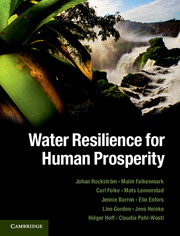Book contents
- Frontmatter
- Contents
- List of Contributors
- Preface
- Introduction to the book
- Acknowledgements
- Part I A new perspective
- Part II Living in a human-dominated world
- Part III Food production globally: in hotspot regions and in the landscape
- 5 Food production: a mega water challenge
- 6 Closing the yield gap in the savannah zone
- 7 Water resources and functions for agro-ecological systems at the landscape scale
- Part IV Governance and pathways
- Glossary
- Index
- References
5 - Food production: a mega water challenge
from Part III - Food production globally: in hotspot regions and in the landscape
Published online by Cambridge University Press: 05 August 2014
- Frontmatter
- Contents
- List of Contributors
- Preface
- Introduction to the book
- Acknowledgements
- Part I A new perspective
- Part II Living in a human-dominated world
- Part III Food production globally: in hotspot regions and in the landscape
- 5 Food production: a mega water challenge
- 6 Closing the yield gap in the savannah zone
- 7 Water resources and functions for agro-ecological systems at the landscape scale
- Part IV Governance and pathways
- Glossary
- Index
- References
Summary
This chapter analyses the pressure on the Earth System caused by escalating agricultural production from the perspective of efforts to feed a growing human population. The focus is on the situation by 2050. Particular attention is paid to improvements in water productivity and efforts to close the currently large yield gap in the developing world. Presented estimates reveal what can be achieved on what is currently cropland. What emerges is a carrying capacity overshoot for more than half the world’s population, which must be compensated for through virtual water transfers in food traded from water surplus countries. The chapter analyses the ability of the agricultural system and its support systems to cope with shocks and change in the Anthropocene era, and the adaptability and social–ecological resilience required to deal with a more turbulent world.
Food demand trajectories and water preconditions
Hunger alleviation and population increase: two strong driving forces at work
Until the beginning of the twentieth century, increasing food production to meet the needs of a growing world population was essentially a case of continuing the expansion of the area of cultivated land. As far back as the nineteenth century there was a growing pessimism about the possibility of feeding a constantly growing population, which was put into words by Thomas Malthus (1766–1834). During the twentieth century the global population increased by more than 350%, from 1.65 billion to more than 6 billion (UNDP, 2004).
After World War II, rapid population increases were not matched by an equal increase in food production in many of the newly independent developing countries. As a result, by the mid-1960s many of these states were dependent on massive food aid from the industrialised world. In 1967, a report by the US President’s Science Advisory Committee stated that ‘the scale, severity and duration of the world food problem are so great that a massive, long-range, innovative effort unprecedented in human history will be required to master it’ (IFPRI, 2002).
- Type
- Chapter
- Information
- Water Resilience for Human Prosperity , pp. 142 - 171Publisher: Cambridge University PressPrint publication year: 2014



